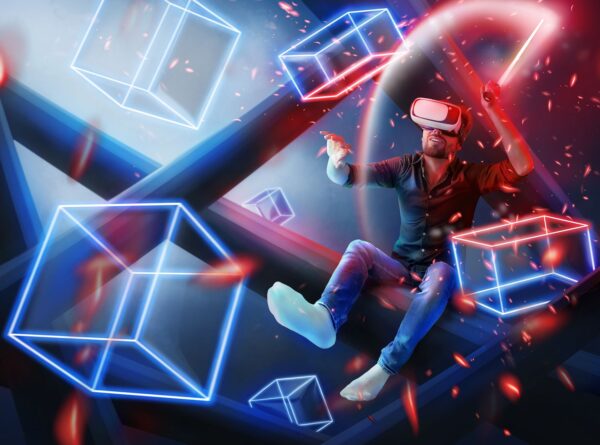Exploring the Digital Frontier: The Evolution and Impact of Virtual Space
As technology continues to advance at a breakneck pace, the concept of “virtual space” is emerging as a transformative force that is reshaping our interactions and experiences. This digital expanse, once confined to the realm of science fiction, is now becoming an integral part of our everyday lives. From virtual reality (VR) to augmented reality (AR), the boundaries between the virtual and physical worlds are increasingly intertwined, offering both groundbreaking opportunities and complex challenges.
Defining Virtual Space:
Virtual space encompasses a broad spectrum of digital environments where users can engage with one another and interact with digital elements in a simulated setting. These spaces are not restricted by the limitations of the physical world, allowing for the creation of innovative experiences that transcend traditional boundaries. Virtual spaces can range from simple text-based chat rooms and social media platforms to elaborate 3D simulations and immersive VR environments. This versatility enables users to explore new dimensions of interaction, creativity, and connectivity.
The Evolution of Virtual Space:
The emergence of virtual space is driven by several key factors. Advances in technology, coupled with the proliferation of high-speed internet, have paved the way for increasingly sophisticated digital environments. Social media platforms, initially designed for text and image sharing, have evolved into dynamic virtual spaces where users can engage in real-time interactions. The advent of VR and AR technologies has further expanded the possibilities, allowing users to immerse themselves in richly detailed virtual worlds that offer new ways to socialize, learn, and create.
Redefining Social Interaction:
One of the most profound impacts of virtual space is on the nature of social interaction. Traditional social media platforms have already altered the way we communicate, but virtual spaces introduce a new level of engagement. In these environments, users can craft avatars that serve as digital representations of themselves, enabling more personal and immersive interactions. This can foster deeper connections and enhance the quality of online relationships. However, it also raises questions about identity, authenticity, and the potential for digital disconnection.
Transforming the Future of Work:
The shift towards remote work has highlighted the potential of virtual spaces to revolutionize the workplace. Companies are increasingly exploring virtual environments for meetings, collaboration, and training. This shift offers numerous benefits, including reduced overhead costs, greater flexibility, and the ability to connect with colleagues from around the globe. However, it also presents challenges related to maintaining work-life balance, managing digital fatigue, and ensuring effective communication in a virtual setting.

Navigating Challenges and Seizing Opportunities:
The challenges associated with virtual space are significant, yet they are matched by equally compelling opportunities. Privacy and security are paramount concerns, as virtual environments can be susceptible to data breaches and cyberattacks. Additionally, the immersive nature of virtual spaces raises ethical considerations, such as the risk of addiction and the impact on mental health. Addressing these challenges requires a thoughtful approach to design, regulation, and user education.
On the flip side, the potential for innovation in virtual space is immense. Industries such as education, healthcare, and entertainment stand to benefit from the advancements in virtual technology. For instance, virtual classrooms can offer immersive learning experiences that engage students in new ways, while virtual healthcare platforms can provide remote consultations and treatments. The possibilities are vast and varied, limited only by our imagination and creativity.
Looking Ahead:
As we continue to explore and develop virtual spaces, it is essential to navigate the challenges while embracing the opportunities they present. The future of virtual space is a dynamic and evolving landscape, one that promises to redefine how we interact, work, and experience the world. By leveraging the potential of virtual technology and addressing its challenges proactively, we can shape a future where virtual space enhances our lives and enriches our connections in meaningful ways.
FAQs:
1. What is virtual space?
Virtual space refers to digital environments where users can interact with each other and digital objects in a simulated world. These environments can range from simple chat rooms and social media platforms to complex 3D worlds experienced through virtual reality (VR) and augmented reality (AR). Virtual space allows for experiences that transcend physical limitations and can offer immersive, interactive engagements.
2. How does virtual space differ from traditional digital platforms?
While traditional digital platforms like social media and websites facilitate communication and content sharing, virtual space provides a more immersive and interactive experience. In virtual space, users can navigate 3D environments, interact with virtual objects, and engage with other users through avatars, creating a more lifelike and engaging experience compared to static or two-dimensional digital platforms.
3. What technologies are used to create virtual spaces?
Virtual spaces are created using a variety of technologies, including virtual reality (VR), augmented reality (AR), 3D modeling, and simulation software. VR creates fully immersive digital environments that users can explore through specialized headsets, while AR overlays digital information onto the real world through devices like smartphones and AR glasses. 3D modeling and simulation software are used to design and build these virtual environments.
4. How can virtual spaces impact social interactions?
Virtual spaces can enhance social interactions by allowing users to create avatars and engage in real-time, immersive experiences with others. This can lead to deeper connections and more meaningful interactions compared to traditional online communication. However, it also raises concerns about identity and authenticity, as users may present idealized versions of themselves or experience a disconnect between their virtual and real identities.
5. What are the potential benefits of using virtual space for work?
Virtual spaces offer several benefits for work, including the ability to conduct remote meetings, collaborate on projects in real-time, and create virtual workspaces that reduce the need for physical office space. These environments can enhance productivity by providing flexible work arrangements and enabling global collaboration. However, challenges such as maintaining work-life balance and managing digital fatigue must be addressed.
6. What challenges are associated with virtual spaces?
Challenges associated with virtual spaces include concerns about privacy and security, as users may be vulnerable to data breaches and cyberattacks. Additionally, the immersive nature of virtual environments can lead to issues such as addiction, digital burnout, and the potential negative impact on mental health. Addressing these challenges requires careful design, regulation, and user education.
7. How can virtual space be used in education?
In education, virtual space can create immersive learning experiences through virtual classrooms, interactive simulations, and collaborative projects. Students can engage in hands-on activities, explore virtual environments, and interact with instructors and peers in a more dynamic way. This can enhance learning outcomes and make education more accessible to students around the world.
8. What are some real-world applications of virtual space?
Virtual space has a wide range of real-world applications, including entertainment (e.g., gaming and virtual concerts), healthcare (e.g., remote consultations and therapy), and design (e.g., virtual prototypes and architectural visualization). Other applications include virtual tourism, where users can explore destinations virtually, and virtual events, which enable people to attend conferences, exhibitions, and social gatherings online.
9. How can users ensure their safety in virtual spaces?
Users can ensure their safety in virtual spaces by using strong passwords, enabling two-factor authentication, and being cautious about sharing personal information. It is also important to be aware of privacy settings and the permissions granted to virtual environments and applications. Staying informed about potential security risks and practicing good digital hygiene can help mitigate potential threats.
10. What does the future hold for virtual space?
The future of virtual space is likely to be characterized by continued innovation and expansion. Advances in technology will enhance the realism and interactivity of virtual environments, making them more integrated into our daily lives. As virtual space evolves, it will offer new opportunities for social interaction, work, education, and entertainment, while also presenting ongoing challenges that will need to be addressed through thoughtful development and regulation.


